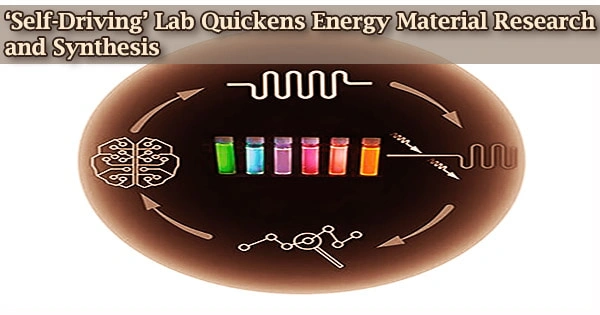In order to expand our knowledge of metal halide perovskite (MHP) nanocrystals, researchers from North Carolina State University and the University at Buffalo have created and shown a “self-driving lab” that combines artificial intelligence (AI) and fluidic systems. Investigations into a wide range of additional semiconductor and metallic nanomaterials can also be conducted in this self-driving lab.
“We’ve created a self-driving laboratory that can be used to advance both fundamental nanoscience and applied engineering,” says Milad Abolhasani, corresponding author of a paper on the work and an associate professor of chemical and bimolecular engineering at NC State.
Cesium lead halide (CsPbX3, X=Cl, Br), an all-inorganic metal halide perovskite (MHP) nanocrystal, was the main focus of the researchers’ proof-of-concept experiments. MHP nanocrystals are a new class of semiconductor materials that are expected to have application promise in printed photonic devices and energy technologies due to their solution-processability and distinctive size- and composition-tunable features.
MHP nanocrystals, for instance, are very effective optically active materials that are being considered for application in next-generation LEDs. Additionally, they may be produced economically because solution processing may be used to create them.
High-value materials like quantum dots, metal/metal oxide nanoparticles, and metal-organic frameworks are examples of materials that can be produced utilizing liquid chemical precursors through a technique known as solution processing.
However, MHP nanocrystals are not in industrial use yet.
“In part, that’s because we’re still developing a better understanding of how to synthesize these nanocrystals in order to engineer all of the properties associated with MHPs,” Abolhasani says. “And, in part, because synthesizing them requires a degree of precision that has prevented large-scale manufacturing from being cost-effective. Our work here addresses both of those issues.”
The new innovation builds upon the Artificial Chemist 2.0 concept that Abolhasani’s lab revealed in 2020. Artificial Chemist 2.0 is a fully autonomous system that performs multi-step chemical synthesis and analysis using AI and automated robotic technologies.
In actual application, that system concentrated on adjusting the MHP quantum dots’ bandgap, enabling users to move from asking for a certain quantum dot to finishing the necessary R&D and starting production in less than an hour.
We’re excited about how this technology will broaden our understanding of how to control the properties of these materials, but it’s worth noting that this system can also be used for continuous manufacturing,. So you can use the system to identify the best possible process for creating your desired nanocrystals, and then set the system to start producing material nonstop and with incredible specificity. We’ve created a powerful technology. And we’re now looking for partners to help us apply this technology to specific challenges in the industrial sector.
Milad Abolhasani
“Our new self-driving lab technology can autonomously dope MHP nanocrystals, adding manganese atoms into the crystalline lattice of the nanocrystals on-demand,” Abolhasani says.
Manganese doping of the substance modifies the optical and electrical properties of the nanocrystals and adds magnetic features to the substance. For instance, manganese doping of the MHP nanocrystals can alter the wavelength of light emitted from the substance.
“This capability gives us even greater control over the properties of the MHP nanocrystals,” Abolhasani says. “In essence, the universe of potential colors that can be produced by MHP nanocrystals is now larger. And it’s not just color. It offers a much greater range of electronic and magnetic properties.”
A much faster and more effective way to comprehend how to manufacture MHP nanocrystals to achieve the appropriate combination of attributes is also provided by the new self-driving lab technology.
“Let’s say you want to get an in-depth understanding of how manganese-doping and bandgap tuning will affect a specific class of MHP nanocrystals, such as CsPbX3,” Abolhasani says.
“There are approximately 160 billion possible experiments that you could run, if you wanted to control for every possible variable in each experiment. Using conventional techniques, it would still generally take hundreds or thousands of experiments to learn how those two processes manganese-doping and bandgap tuning would affect the properties of the cesium lead halide nanocrystals.”
However, the new system completes all of this on its own. Its AI program specifically chooses and conducts its own experiments. The outcomes of each completed experiment guide the choice of the subsequent experiment, and this process is continued until it is clear which mechanisms govern the various attributes of the MHP.
“We found, in a practical demonstration, that the system was able to get a thorough understanding of how these processes alter the properties of cesium lead halide nanocrystals in only 60 experiments,” Abolhasani says. “In other words, we can get the information we need to engineer a material in hours instead of months.”
While the work in the paper focuses on MHP nanocrystals, other solution-processed nanomaterials, such as a wide range of metallic and semiconductor nanomaterials, might also be characterized using the autonomous system.
“We’re excited about how this technology will broaden our understanding of how to control the properties of these materials, but it’s worth noting that this system can also be used for continuous manufacturing,” Abolhasani says.
“So you can use the system to identify the best possible process for creating your desired nanocrystals, and then set the system to start producing material nonstop and with incredible specificity. We’ve created a powerful technology. And we’re now looking for partners to help us apply this technology to specific challenges in the industrial sector.”
In the journal Advanced Intelligent Systems, a study titled “Autonomous Nanocrystal Doping by Self-Driving Fluidic Micro-Processors” is available online without a subscription.
The paper was co-authored by Fazel Bateni, a Ph.D. student at NC State; Robert Epps and Jeffery Bennett, postdoctoral researchers at NC State; Kameel Antami, a former Ph.D. student at NC State; Rokas Dargis, an undergraduate at NC State; and Kristofer Reyes, an assistant professor at the University at Buffalo. The National Science Foundation, through award number 1940959, and the UNC Research Opportunities Initiative both provided funding for the project.





